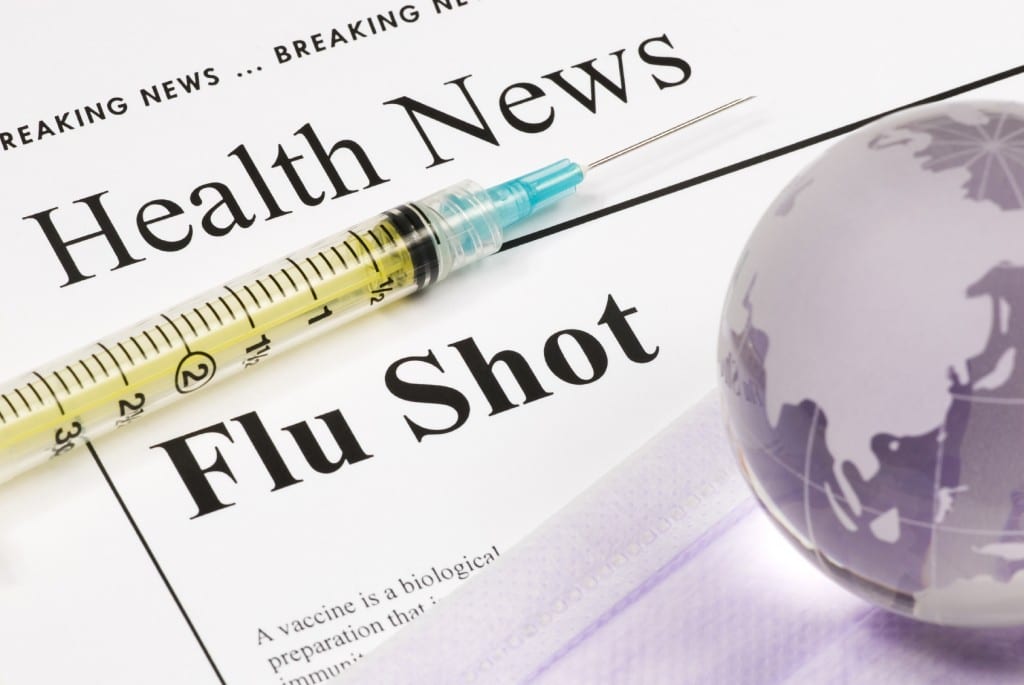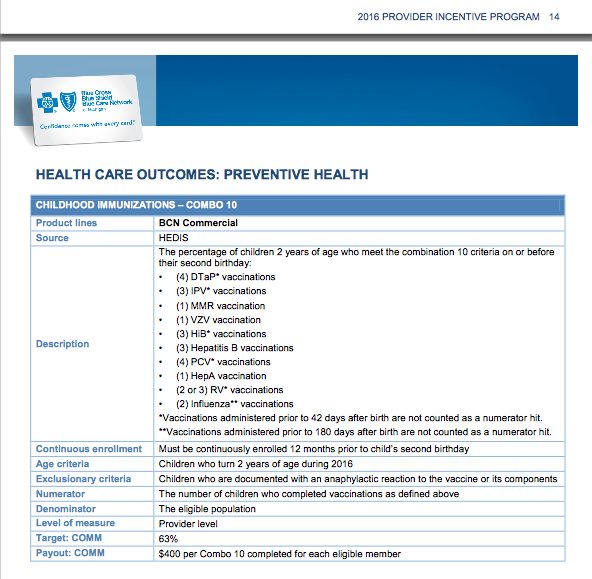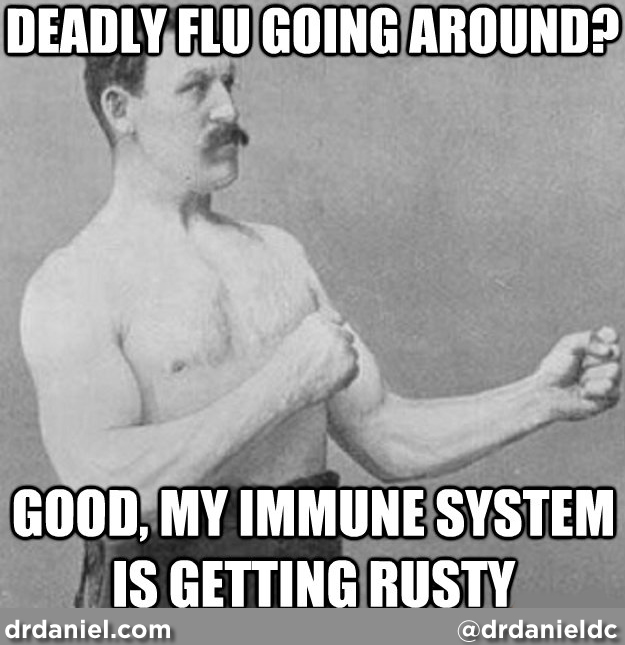The push to get everyone vaccinated against influenza (or the flu) every year is here.
That's right… Flupocalypse is in full swing and those nasty bugs are comin' to getcha!
And every year… someone always asks me, “Why don't you get the flu shot?”
Not only do flu vaccines include suspect ingredients, but the evidence shows that they flat out don't work.
In fact, about the only thing flu vaccines are truly good for is profits for some shareholders. If that's you… then congrats and let me know so I can send you my Christmas list.
The Scientific Evidence Does Not Support Having a Yearly Flu Vaccine
Most notably, studies have consistently shown that flu shots simply don't work.
For instance:
- The Archives of Pediatric & Adolescent Medicine has reported that giving young children flu shots appeared to have no impact on flu-related doctor visits or hospitalizations during two recent flu seasons.
- And research published in the American Journal of Respiratory and Critical Care Medicine similarly reports that there has been no decrease in deaths from influenza and pneumonia, despite the fact that vaccination coverage among the elderly has increased from 15 percent in 1980 to 65 percent today.
- The British Medical Journal (BMJ) researched 259 studies on influenza vaccine efficacy and concluded that vaccine industry and government sponsored studies were of considerably lower quality and more in favor of vaccination. That is, the higher the quality and the more independently resourced, the less likely the study was to support vaccination.
- A large-scale, systematic review of 50 studies published in the Cochrane Database of Systematic Reviews found that the flu vaccine was no more effective for children than a placebo.
Cochrane specifically states that the flu vaccine is:
- Not effective for children under age 18 or adults over 65.
- Between ages 18-65, it is only 30-50% effective in an average year (which means it fails 50-70% of the time) and up to 80% in a perfectly matched year (Keep in mind that this year.. 2017, it's 10% matched)
- There is no decrease in flu transmission rate or hospitalization rate for people who have gotten the flu vaccine.
Here is the Cochrane Review's results and conclusions:
MAIN RESULTS:
We included 50 reports. Forty (59 sub-studies) were clinical trials of over 70,000 people. Eight were comparative non-RCTs and assessed serious harms. Two were reports of harms which could not be introduced in the data analysis. In the relatively uncommon circumstance of vaccine matching the viral circulating strain and high circulation, 4% of unvaccinated people versus 1% of vaccinated people developed influenza symptoms (risk difference (RD) 3%, 95% confidence interval (CI) 2% to 5%). The corresponding figures for poor vaccine matching were 2% and 1% (RD 1, 95% CI 0% to 3%). These differences were not likely to be due to chance. Vaccination had a modest effect on time off work and had no effect on hospital admissions or complication rates. Inactivated vaccines caused local harms and an estimated 1.6 additional cases of Guillain-Barré Syndrome per million vaccinations. The harms evidence base is limited.
AUTHOR'S CONCLUSIONS:
Influenza vaccines have a modest effect in reducing influenza symptoms and working days lost. There is no evidence that they affect complications, such as pneumonia, or transmission. WARNING: This review includes 15 out of 36 trials funded by industry (four had no funding declaration). An earlier systematic review of 274 influenza vaccine studies published up to 2007 found industry funded studies were published in more prestigious journals and cited more than other studies independently from methodological quality and size. Studies funded from public sources were significantly less likely to report conclusions favorable to the vaccines. The review showed that reliable evidence on influenza vaccines is thin but there is evidence of widespread manipulation of conclusions and spurious notoriety of the studies. The content and conclusions of this review should be interpreted in light of this finding.
After analyzing all of the data on the flu shot, they have concluded that it really doesn’t work well. It doesn’t even cover most of the influenza infections that people get.
In addition, there is a 126-page analysis by researchers at the University of Minnesota’s Center for Infectious Disease Research & Policy (CIDRAP). Among the key findings of this 2012 analysis (in the researchers’ own words):
- Influenza vaccine protection is markedly lower than for most routinely recommended vaccines and is suboptimal.
- CDC recommendations about the flu vaccine over the past 30 years have not been based on scientifically sound data.
And since those studies have been published, flu vaccine efficacy rates have hit new lows.
This year FluMist, the nasal spray influenza vaccine, is no longer recommended.
Why? Because it doesn’t work at all.
In the words of the CDC, “no protective benefit could be measured.”
Oops.
If the Flu Vaccine Doesn't Work, Why such a Strong Push for Vaccination?
Why is there always such a ridiculous push for a vaccine that doesn’t work, that prompted more government pay-outs because of adverse events, including death, than any other vaccine in 2017 so far, and that also contains ingredients analyzed by CDC scientists and found, in a recent peer-reviewed paper, to be highly neurotoxic?
Like in all good secrets exposed… follow the money.
Could it be the ridiculous bonuses insurance companies pay to medical groups for vaccine compliance among their staff and their patients?
As the table above explains, Blue Cross Blue Shield pays pediatricians $400 per fully vaccinated child. If your pediatrician has just 100 fully-vaccinated patients turning 2 this year, that’s $40,000. Yes, Blue Cross Blue Shield pays your doctor a $40,000 bonus for fully vaccinating 100 patients under the age of 2. If your doctor manages to fully vaccinate 200 patients, that bonus jumps to $80,000.
SHUT THE FRONT DOOR!
But here’s the catch: Under Blue Cross Blue Shield’s rules, pediatricians lose the whole bonus unless at least 63% of patients are fully vaccinated, and that includes the flu vaccine.
Errrbody gettin tipsy (with a flu vaccine)!!!!
Could it also be the hundreds of thousands of dollars paid to politicians and decision makers by a powerful pharmaceutical lobby?
An 8-year period of donations by pharmaceutical companies that manufacture vaccines given to the American Academy of Pediatricians exceeded 9.4 million dollars (The Business of Baby, p. 223).
Influenza (The Flu) Is Not A Serious Threat
How many people do you know have died from having the flu? Mostly likely none.
In 2005 Peter Doshi – Assistant Professor at the University of Maryland School of Pharmacy and Associate Editor of BMJ (British Medical Journal) – wrote an article exposing how the CDC spins its death by “pneumonia and influenza” statistics.
According to the CDC’s National Center for Health Statistics (NCHS), “influenza and pneumonia” took 62,034 lives in 2001 – 61,777 of which were attributed to pneumonia and 257 to flu. In only 18 cases was flu virus positively identified.
According to the CDC:
“Over a period of 30 years, between 1976 and 2006, estimates of flu-associated deaths in the United States range from a low of about 3,000 to a high of about 49,000 people.” The range is so great because the tests to diagnose an influenza virus from one of the 150-200 pathogens that produce flu-like symptoms are not sensitive enough to decipher the difference.
The CDC uses respiratory and circulatory (R&C) deaths as “the primary outcome in its mortality modeling because R&C deaths provide an estimate of deaths that include secondary respiratory or cardiac complications that follow influenza.”
It admits, though, that “only 2.1% of all respiratory and circulatory deaths were influenza-related.”
In addition, a 2010 study published in the International Journal of Medicine concluded that the flu vaccine contributes to cardiovascular inflammation, and thus may increase the risk of heart attack.
The CDC uses pneumonia and influenza (P&I) deaths as a secondary mortality model, yet it again admits that “only 8.5% of all pneumonia and influenza deaths were influenza-related.”
Remember, getting the flu during the fall and winter months is not inevitable just because health professionals propose this time to be “flu season.”
Frequent hand washing with regular soap (not anti-bacterial) and a healthy lifestyle are far better and safer ways to prevent the onset of the flu than any pharmaceutical medication or vaccine on the market.
If you’re concerned about getting the flu, speak with a physician that has a solid knowledge of natural ways to keep you healthy.
Closing Thoughts
Do yourself a favor and pay attention to your vitamin D status, optimize your diet by focusing on antioxidant-rich fruits and vegetables, eat lean and clean protein, consume bone broths (chicken or beef stock made at home) and healthy anti-inflammatory fats from fish, nuts, and seeds, and healthy olive, grape seed, and coconut oils.
Stay well hydrated, practice common sense hygiene, and create time to rest and restore your energy.
Wishing you and your loved ones health and happiness!







